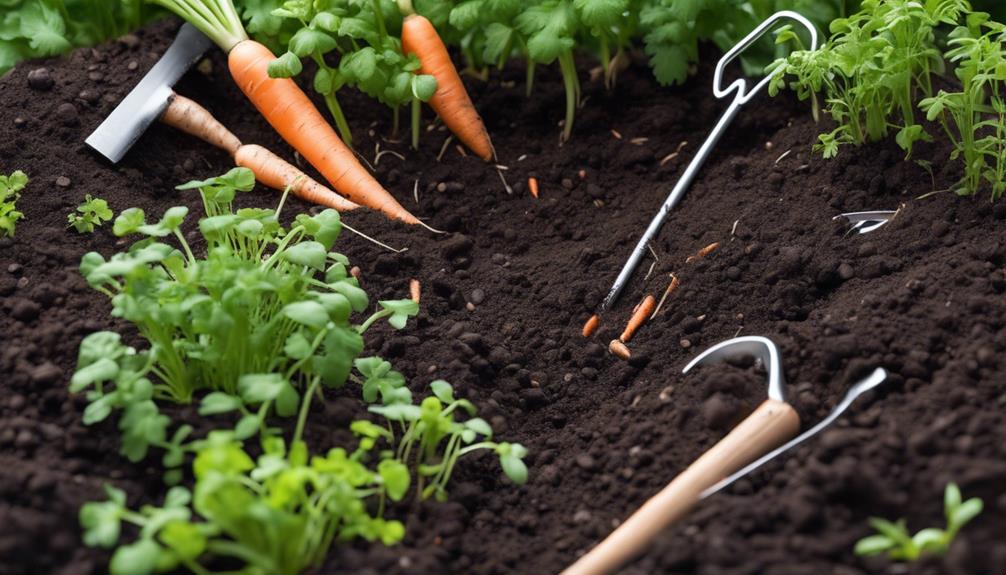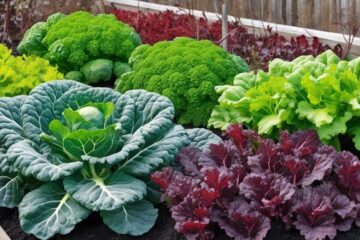To grow, to thrive, to harvest—these are your goals when it comes to cultivating carrots in your home garden.
You’ve likely heard that the secret lies in the soil, but what does that really mean for you and your garden? Starting with soil that’s loose, well-drained, and within the ideal pH range is crucial.
However, there’s more to to than just these basics. By understanding the intricacies of soil preparation and maintenance, you can greatly improve your carrot crop.
Let’s explore how you can create the perfect environment for your carrots to flourish, ensuring a bountiful and delicious harvest.
Optimal Soil Composition for Carrots
Optimal soil composition plays a pivotal role in the successful cultivation of carrots, necessitating a blend of loose, well-drained soil enriched with organic matter such as compost. This enrichment not only supplies essential nutrients but also enhances the soil’s structure, promoting the development of healthy, vigorous carrot roots. The ideal soil for carrots is sandy loam, which prevents compaction, allowing roots to penetrate deeply and grow evenly. This soil type facilitates proper aeration and moisture retention, essential factors for carrot growth.
Before planting, meticulous soil preparation is crucial. This involves the thorough removal of rocks and debris, which can obstruct root growth, and breaking up clods to ensure a finely textured, aerated soil that carrots favor. Achieving this texture encourages uniform root development, resulting in straight and well-formed carrots.
Moreover, selecting the right location is paramount for carrot cultivation. Carrots demand a position that receives 6 to 8 hours of direct sunlight daily, underpinning their need for ample photosynthesis to flourish. While sunlight is a critical factor, the inherent quality of the soil at the chosen site cannot be overlooked. It must naturally facilitate good drainage to prevent waterlogging, which can lead to root rot. In scenarios where natural soil conditions are less than ideal, opting for raised beds can offer a viable solution, providing gardeners with the opportunity to tailor soil composition and drainage, thereby optimizing conditions for carrot growth. Through careful attention to soil composition and preparation, gardeners can significantly enhance their carrot harvest, yielding a bountiful crop of this nutritious root vegetable.
Ph Levels for Thriving Carrots
The pH level of the soil is a critical factor in the successful cultivation of carrots. For carrots to thrive, they require a soil pH within the optimal range of 6.0 to 6.5, which is slightly acidic to neutral. This pH range is ideal as it enhances the soil’s capacity to supply essential nutrients, which are pivotal for the healthy development and growth of carrot plants. The availability of these nutrients at the correct pH levels ensures that carrots can absorb them effectively, supporting the development of robust roots and vibrant foliage.
Before planting carrots, it is imperative to test the soil’s pH to ascertain its suitability for carrot growth. This preliminary step allows gardeners to make necessary adjustments to the soil composition, ensuring it meets the specific requirements of carrot plants. If the soil’s pH falls outside the ideal range, amendments such as lime (to raise the pH) or sulfur (to lower the pH) can be applied. These amendments adjust the soil pH, creating an environment conducive to carrot growth.
Maintaining the correct soil pH is not only about facilitating nutrient uptake but also about preventing the soil conditions that can lead to poor growth and development of the carrots. Imbalances in soil pH can hinder the carrots’ ability to absorb nutrients, leading to suboptimal growth and potentially affecting the quality of the harvest. Therefore, monitoring and adjusting the soil pH as needed is essential for fostering the growth of healthy, nutritious carrots. Through diligent soil pH management, gardeners can ensure their carrot plants develop strong roots and flourish, ultimately yielding a bountiful and tasty crop.
| Key | Information |
|---|---|
| pH Levels | 6.0 to 6.5 (optimal) |
| Soil | Slightly acidic to neutral |
| Carrots | Require specific pH range |
| Lime | Used for pH adjustments |
Ideal Planting Locations for Carrots
Choosing the ideal planting location is paramount for cultivating carrots that are both healthy and vibrant. These root vegetables demand a location bathed in sunlight for at least 6-8 hours a day. Such ample exposure ensures that carrots can photosynthesize effectively, which is essential for their growth and development. In addition to sunlight, carrots require well-drained, nutrient-rich soil with a pH ranging from 6.0 to 6.5, striking the perfect balance for nutrient absorption and root development.
For gardeners looking to optimize their carrot cultivation, considering raised beds or containers might be a strategic move. These alternatives offer enhanced control over soil conditions, including drainage and nutrient content. Raised beds and containers can be particularly beneficial in areas where native soil does not meet the ideal conditions for carrot growth, allowing for tailored soil mixtures that cater precisely to the needs of carrot plants.
Deep tilling of the soil to a depth of at least 12 inches is another critical step for preparing the ideal planting location. This practice breaks up compacted soil, removes obstacles that could impede root growth, and ensures the soil is loose and aerated. Incorporating organic matter into the soil at this stage can significantly improve its fertility, structure, and moisture retention capabilities, creating an environment where carrots can thrive.
Selecting the right spot in your garden, with attention to sunlight, soil quality, and proper preparation, sets the stage for successful carrot growth. By providing carrots with their preferred conditions, gardeners can look forward to harvesting plump, flavorful carrots from their home gardens. This careful preparation and choice of location underscore the importance of environment in vegetable cultivation, offering a rewarding gardening experience and a fruitful harvest.
Recommended Soil Amendments for Carrots
| Soil Amendment | Recommended Amount |
|---|---|
| Garden Lime | Incorporate to sweeten acidic soil |
| Leaf Litter or Compost | 2 to 4 inches for soil improvement and nutrient supply |
| All-purpose Fertilizer | 2 to 4 cups per 100 feet of bed for essential nutrients |
| Deep Cultivation | Avoid near plants to prevent root damage |
Sunlight and Water Needs for Carrots
For carrots to flourish and yield sweet, flavorful roots, ensuring they receive sufficient sunlight and consistent moisture is fundamental. Carrots flourish under full sun exposure, necessitating 6-8 hours of direct sunlight each day. This ample sunlight is pivotal for the process of photosynthesis, which plays a critical role in the carrots’ ability to absorb nutrients vital for robust root development.
Equally important to sunlight is the need for proper irrigation practices. Carrots thrive in conditions where moisture is consistent yet the soil remains well-drained. Overly saturated soil can lead to root rot, while under-watering can stress the plants, affecting their growth and root formation. To strike the right balance, regular watering routines are essential, particularly during periods of low rainfall, to maintain soil moisture at a level conducive to optimal carrot growth.
The consequences of inadequate sunlight include stunted growth and the development of smaller, less flavorful roots, significantly impacting the quality of your harvest. By prioritizing both the sunlight exposure and watering needs of your carrot plants, you create an environment that supports their growth cycle from seedling to harvest. Remember, it’s the attention to these fundamental needs that paves the way for a successful and rewarding carrot crop, characterized by healthy growth and bountiful yields.
Frequently Asked Questions
What Is the Secret to Growing Good Carrots?
To grow good carrots, plant in loose, well-drained soil with a pH of 6.0 to 6.5. Prepare soil by tilling deep and adding organic matter. Direct sow seeds, space them properly, fertilize regularly, provide full sun, and water consistently for thriving homegrown carrots.
What Is the Best Fertilizer for Carrots?
For your carrots, choose a balanced fertilizer with more phosphorus and potassium, like a 5-10-10 or 10-20-20 mix. Avoid too much nitrogen to prevent leafy growth over roots. Organic options like compost or manure can also nourish your carrots well.
What Makes Carrots Grow Better?
To make those carrots flourish, you need the right conditions. Plant them in sunny spots, space those seeds just right, and pamper them with well-draining soil. Give them air and nutrients – watch them thrive!
Should I Add Sand to Soil to Grow Carrots?
Yes, add sand to soil for growing carrots. Sand mixed with clay or organic matter improves drainage, prevents root rot, and aids in straight root development. Sandy loam soil allows easy root growth. Your carrots will thrive!
Conclusion
So, now that you’ve learned about the best soil tips for thriving carrots in your home garden, put them to the test and watch your carrots flourish!
Remember, soil preparation and pH levels play a crucial role in the health and growth of your carrots.
By following these tips and investigating the truth behind them, you’ll be on your way to enjoying a bountiful harvest of delicious, home-grown carrots in no time! Get more tips for your vegetables here!





